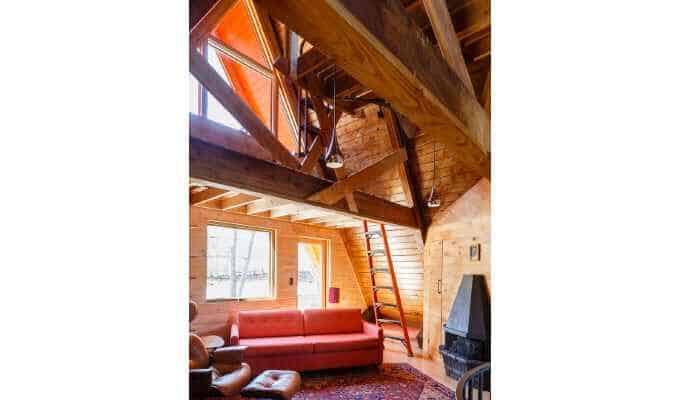A desire to bring the Hamptons back to their quaint and natural roots is pushing architects and designers to maximize the space in homes with smaller square footage. Towns like East Hampton and Southampton are encouraging residents to either remodel existing structures or build new ones that leave as much property around them as possible.
The idea, noted Douglas Elliman broker Ronnie Diamonde, is to preserve the Hamptons’ history and aesthetic. He experienced the trend personally when he renovated his 105-year-old farmhouse in Southampton two years ago, sticking with its 1,900 square feet rather than rebuilding or attaching an addition. “When I restored my house, the Village was in awe. They were so happy,” Diamonde said. “I had a few neighbors knock on my door and thank me for keeping the original structure.”
And while some believe that the bigger the house, the more it’s worth on the market, historic homes often command top dollar for their charm and character.
“Typically, everyone thinks that the square feet is what determines value, but to me it’s really about the efficiencies you can pack into those square feet,” said Sag Harbor-based architect Edgar Papazian, who has completed numerous renovations. The key, he said, is a floor plan that makes the best use of the space available. For example, Papazian removes walls when possible, and creates designated spaces for dining, living and a kitchen without them. “You can use low barriers that indicate different areas, like a bank of cabinets can divide the living room from the dining area,” he explained.

Since many East End homes are vacation retreats for city residents, they are often also used for storage, but you don’t need a huge house for that purpose. Instead, basements and outdoor sheds are great for packing away extra belongings, Papazian said.
From a decor standpoint, making small rooms look bigger is simple with tricks like choosing light colors for wall paint and placing mirrors opposite of windows, interior designer Kristen Farrell said. A quick trip to The Container Store or browsing Amazon.com can yield storage bins that blend well with a home’s style. Cutting back on clutter is necessary sometimes, too. “Purge what you don’t need and organize what you have,” Farrell said.
When building new projects, architect Paul Masi, of the firm Bates Masi Architects, finds that the first thing to limit square footage is a budget. However, even if money is not an issue, he still aims to construct houses that are just big enough for what his clients need. “We try to go from the aspect of how many bedrooms do you need? Do you want a gym? Do you want an office?” he said. For rooms that are small, windows do wonders.
Some of his projects have entire walls of glass that make their interiors feel like they extend indefinitely outside. When clients do push for a larger structure, Masi said he gently reminds them that the bigger the house, the less outdoor space they’ll have to enjoy. “It’s even more populated and dense out here than it used to be, and those vacant lots that we all saw as kids growing up are gone,” he said. “There’s a density that’s affecting the landscape, and people realize that and they want the landscape.”












!['The Maples' is a prestigious generational compound of two extraordinary estates: 18 Maple and 22 Maple. This rare offering, designed by luxury architect Lissoni partners New York and developed by visionaries Alessandro Zampedri-CFF Real Estate and JK Living, redefines opulence with the highest quality of craftsmanship and captivating views of the Atlantic Ocean. Represented by @nycsilversurfer and @challahbackgirl of @douglaselliman. [link in bio]](https://hamptonsrealestateshowcase.com/wp-content/uploads/sb-instagram-feed-images/438891010_1083749139481747_7890082604579275354_nfull.jpg)
![Featuring 360-degree water views on Mecox Bay, the Atlantic Ocean and Channel Pond, 1025 Flying Point offers the ultimate beach cottage that is flooded with natural light. With panoramic views, proximity to the ocean, and a private walkway to Mecox bay for kayaking or paddle boarding, this truly is a special retreat. Represented by @ritcheyhowe.realestate and @hollyhodderhamptons of @sothebysrealty. [link in bio]](https://hamptonsrealestateshowcase.com/wp-content/uploads/sb-instagram-feed-images/438994305_737511778456166_4602476013493875279_nfull.jpg)
![Attention advertisers! 📣 Secure your spot in the highly anticipated Memorial Day edition #HRES. Reach thousands of potential clients and showcase your brand in one of the most sought-after publications in the Hamptons, NYC, Palm Beach, and beyond. Contact us now to reserve your ad space! [link in bio]](https://hamptonsrealestateshowcase.com/wp-content/uploads/sb-instagram-feed-images/438549843_275102939023235_6718257301437562124_nfull.jpg)
![You eat with your eyes, and on the East End, it’s important that what you eat looks just as good as how it tastes. At @rosies.amagansett, the restaurant itself is plenty photo-worthy with blue ceramic tiling and yellow and white striped fabric wallpaper. But for a dish that will light up your photos, head directly to the salmon tartare! [link in bio]](https://hamptonsrealestateshowcase.com/wp-content/uploads/sb-instagram-feed-images/437094269_7296727147115953_1594410326824303644_nfull.jpg)

![We were honored to be the media sponsor for @blackmountaincapital's open house event with @jameskpeyton and @jfrangeskos at 11 Dering Lane in East Hampton! Other sponsors included @landrover, Feline Vodka, @rustikcakestudio, @la_parmigiana, @lahaciendamexicangrill11968, @homesteadwindows, Stone Castle, @talobuilders, and @thecorcorangroup.
A big thank you Carrie Brudner of Black Mountain Capital for putting together this fabulous event! [link in bio]](https://hamptonsrealestateshowcase.com/wp-content/uploads/sb-instagram-feed-images/437081213_762912965932136_6847332836522786568_nfull.jpg)

![Blooms Galore at the Long Island Tulip Festival! 🌷✨ Mark your calendars for April 15th as the vibrant tulips at @waterdrinkerlongisland burst into full bloom! Enjoy a day filled with colorful splendor, food trucks, live music, and more. [link in bio]](https://hamptonsrealestateshowcase.com/wp-content/uploads/sb-instagram-feed-images/437083429_974242677583725_6855805712693638343_nfull.jpg)
